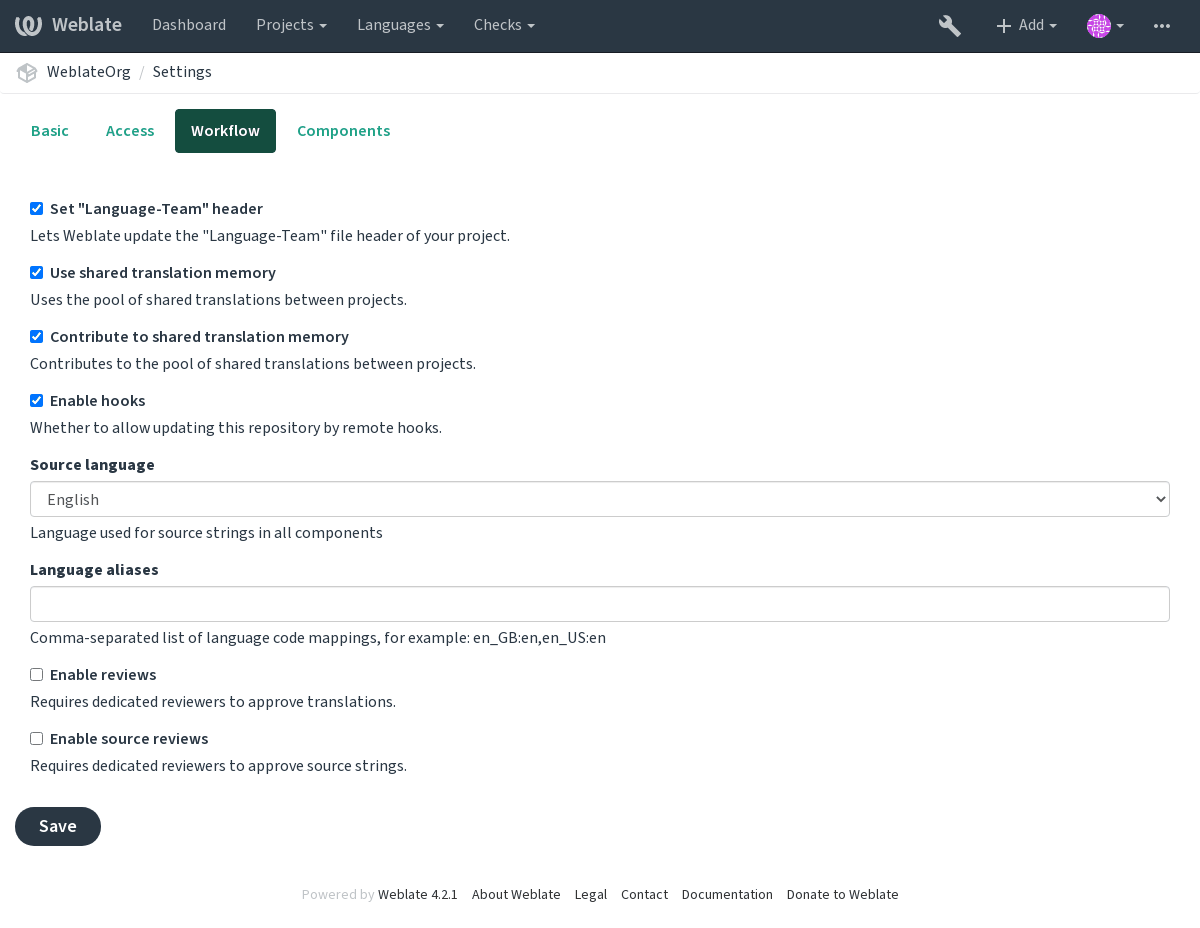Translation workflows¶
Several translation workflows are supported.
The following is not a complete list of ways to configure Weblate. You can base other workflows on the most usual examples listed here.
Translation access¶
The アクセス制御 is not much discussed in the workflows as each access control option can be applied to any workflow. Please consult that documentation for information on how to manage access to translations.
In the following chapters, any user means a user who has access to the translation. It can be any authenticated user if the project is public, or a user that has a Translate permission for the project.
Translation states¶
Each translated string can be in one of following states:
- 未翻訳
Translation is empty, it might or not be stored in the file, depending on the file format.
- 要編集
Translation needs editing, this is usually the result of a source string change. The translation is stored in the file, depending on the file format it might be marked as needing edit (for example as it gets a fuzzy flag).
- 査読待ち
Translation is made, but not reviewed. It is stored in the file as a valid translation.
- 承認済み
Translation has been approved in the review. It can no longer be changed by translators, but only by reviewers. Translators can only add suggestions to it.
- 提案
Suggestions are stored in Weblate only and not in the translation file.
Direct translation¶
This is most usual setup for smaller teams, anybody can directly translate. This is also the default setup in Weblate.
Any user can edit translations.
Suggestions are optional ways to suggest changes, when translators are not sure about the change.
Setting |
Value |
メモ |
|---|---|---|
査読の有効化 |
無効 |
Configured at project level. |
提案の有効化 |
有効 |
It is useful for users to be able to suggest when they are not sure. |
提案への投票 |
無効 |
|
提案の自動採用 |
0 |
|
Translators group |
Users |
Or Translate with アクセス制御. |
Reviewers group |
該当なし |
Not used. |
Peer review¶
With this workflow, anybody can add suggestions, and need approval from additional member(s) before it is accepted as a translation.
Any user can add suggestions.
Any user can vote for suggestions.
Suggestions become translations when given a predetermined number of votes.
Setting |
Value |
メモ |
|---|---|---|
査読の有効化 |
無効 |
Configured at project level. |
提案の有効化 |
有効 |
|
提案への投票 |
無効 |
|
提案の自動採用 |
1 |
You can set higher value to require more peer reviews. |
Translators group |
Users |
Or Translate with アクセス制御. |
Reviewers group |
該当なし |
Not used, all translators review. |
Dedicated reviewers¶
バージョン 2.18 で追加: The proper review workflow is supported since Weblate 2.18.
With dedicated reviewers you have two groups of users, one able to submit translations, and one able to review them to ensure translations are consistent and that the quality is good.
Any user can edit unapproved translations.
Reviewer can approve / unapprove strings.
Reviewer can edit all translations (including approved ones).
Suggestions can also be used to suggest changes for approved strings.
Setting |
Value |
メモ |
|---|---|---|
査読の有効化 |
有効 |
Configured at project level. |
提案の有効化 |
無効 |
It is useful for users to be able to suggest when they are not sure. |
提案への投票 |
無効 |
|
提案の自動採用 |
0 |
|
Translators group |
Users |
Or Translate with アクセス制御. |
Reviewers group |
Reviewers |
Or Review with アクセス制御. |
Turning on reviews¶
Reviews can be turned on in the project configuration, from the Workflow subpage of project settings (to be found in the Manage → Settings menu):

注釈
Depending on Weblate configuration, the setting might not be available to you. For example on Hosted Weblate this is not available for projects hosted for free.
Quality gateway for the source strings¶
In many cases the original source language strings are coming from developers, because they write the code and provide initial strings. However developers are often not a native speakers in the source language and do not provide desired quality of the source strings. The intermediate translation can help you in addressing this - there is additional quality gateway for the strings between developers and translators and users.
By setting 中間言語ファイル, this file will be used as source for the strings, but it will be edited to source language to polish it. Once the string is ready in the source language, it will be also available for translators to translate into additional languages.
Source strings reviews¶
With 原文の査読の有効化 enabled, the review process can be applied on the source strings. Once enabled, users can report issues in the source strings. The actual process depends on whether you use bilingual or monolingual formats.
For monolingual formats, the source string review behaves similarly as with Dedicated reviewers - once issue is reported on the source string, it is marked as Needs editing.
The bilingual formats do not allow direct editing of the source strings (these are typically extracted directly from the source code). In this case Source needs review label is attached to strings reported by translators. You should review such strings and either edit them in the source or remove the label.